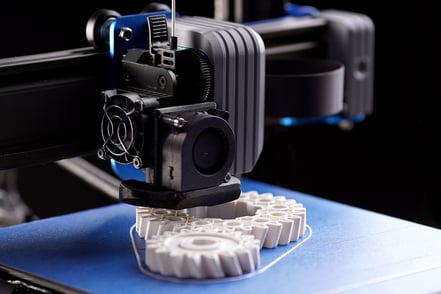Additive manufacturing (AM) has revolutionized large-scale production and is now being used by many of the world's biggest manufacturers due to its advancements in technology, materials, accuracy, and affordability.
Industry leaders like IKEA, The Volkswagen Group and L’Oréal are just a few of many that are using this type of manufacturing technology.
Now is the time for large scale manufacturers to take advantage of additive manufacturing's potential. Adopting the technology can result in improved production efficiency, flexibility, cost savings and greater innovation.
We'll explore these advantages and explain the challenges of transitioning to AM and how to overcome it.
What is Additive Manufacturing?
Additive Manufacturing, also known as 3-D printing, is a process of creating 3-D printing material by adding layer by layer of material in successive passes. Not only can this manufacturing setup be used to create prototypes of complex designs for small-scale projects, but many companies are now using AM on a larger scale.
For example, aerospace manufacturers are using 3-D printing to produce large parts with complex geometry using materials that would otherwise be difficult to manufacture. They’re also using 3D printing to build components out of metal alloys that are lighter than traditional methods.
Similarly, automotive manufacturers are using AM for producing engines and other complex parts. The process allows them to make more efficient and lightweight components using a variety of materials, as well as reduce their development time.
Medical companies too have begun using AM for developing custom surgical implants and prosthetics in their production process. They’re able to create these products at a faster rate and much lower cost compared to traditional processes.
All of these advancements show just how far the adoption of AM has evolved in recent years, and the future of AM looks even brighter as more applications in the design process for this technology continue to be discovered using different materials.
Benefits of Additive Manufacturing for Large-Scale Manufacturers
Large scale manufacturers can benefit from utilizing additive manufacturing technology in a variety of ways.
Cost Savings
It offers cost savings to large scale industrial manufacturers. Traditional manufacturing methods require expensive tooling and setup costs, and the process can be slow. With AM, these expenses are eliminated, if not reduced, because of greater manufacturing flexibility that this technology offers.
Parts can be produced faster with less resources. Manufacturers gain competitive advantage by reducing production times and overall costs. Material costs are also drastically reduced due to the ability to create more complex parts with fewer materials being used in comparison to conventional manufacturing methods.
You can 3-D print various types of raw materials including plastics, ceramics, metals, graphite, and composites as strongly as if they were injection molded or machined from solid metal stock.

Increased Efficiency and Speed of Production
The potential for scaling production is yet another benefit of this technology.
Production runs that would have taken days or weeks using traditional processes can now be completed in a matter of hours or even minutes!
Additive manufacturing technology offers faster iterations and also allows for better quality control and evaluation cycles so companies can get their physical products to market quickly with less risk of failure at launch. They can also prototype new designs and assess any changes much quicker than ever before, further improving product enhancement and increasing profitability margins while taking the guesswork out of product development.
These benefits make AM attractive to large-scale companies who desire rapid prototyping capabilities of their physical products and improved quality control while achieving higher levels of efficiency and cost savings over time.
Challenges in Implementing Additive Manufacturing (And What to do)
Businesses in the manufacturing industry should choose digital technologies based on long-term core objectives while measuring the cost of re-tooling, among many other things to consider when looking at its impact on business models.
Onboarding innovative technologies can seem daunting to large-scale manufacturers. From reprogramming machines, to training personnel and acquiring new skills, it can be difficult to maneuver all elements of the production phases successfully to additive manufacturing paths.
Luckily, manufacturers have access to resources and steps they can take to integrate these cutting-edge methods painlessly.
Do a thorough assessment of the organization’s equipment, production phases, and materials. By understanding what exists currently, it will be easier to identify which additive manufacturing paths will work for the company's main objectives suitable for implementation within the business environment.
It is also essential for manufacturers to assess capability gaps and make sure there is enough staff or technicians trained in these new methods of production to operate additional machines that are needed or added as part of this integration transition.
Having a strong plan with measurable goals is key when going through the transition process from traditional manufacturing methods of production methods into AM capabilities. We suggest beginning with a single system to gain a better understanding of AM techniques prior to evaluating rapid growth.
To ensure long term success, this journey needs ongoing commitment and organizational resources, so that efforts remain flexible even after yields regular returns. It's prudent to inspect results often before making further investments on this track.
Conclusion
Additive manufacturing technology is a powerful tool for large-scale production. It offers faster iterations, improved quality control, and cost savings over time. However, transitioning to this technology can be challenging for manufacturers due to the need for reprogramming machines, training personnel, and acquiring new skills. To ensure long-term success in additive manufacturing, manufacturers should do a thorough assessment of their equipment and production phases , assess capability gaps, and have a strong plan with measurable goals. With the right resources and commitment, manufacturers can reap the benefits of additive manufacturing for large-scale production.
Learn more about how Radwell can help your industrial operation

